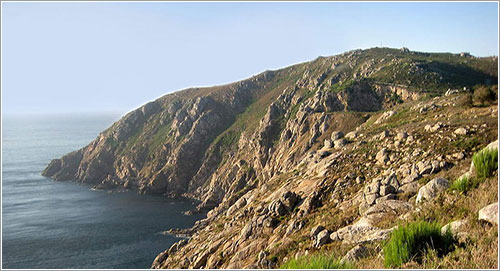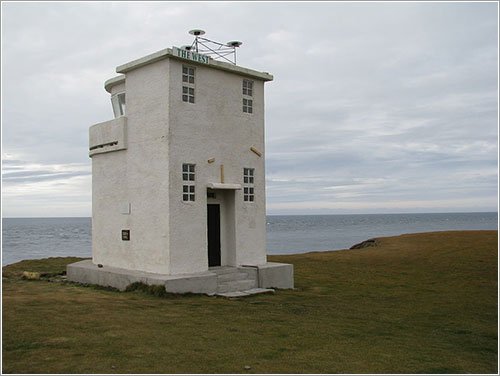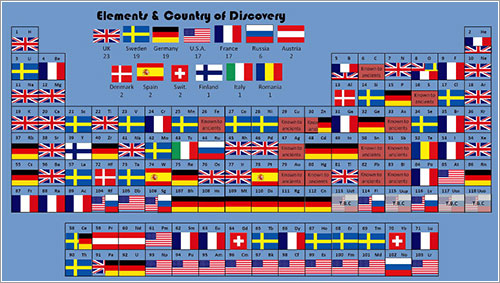
Total Pageviews
Sunday 30 June 2013
Switched On: Form in the USA

FCC approves Google's white space wireless database

The iblazr Flash Will Light Up Your Mobile Phone Pics

La historia de los Lunojod, los primeros rover en recorrer otro astro
Lanzados en noviembre de 1970 y en enero de 1973 los Lunojod 1 y 2 fueron dos rover soviéticos que recorrieron 10 y 37 kilómetros sobre la superficie de la Luna.
De hecho el Lunojod 2 tiene todavía, 40 años después, el récord de distancia recorrida sobre la superficie de otro astro.
El documental Lunokhod: Un Tanque en la Luna cuenta la historia de estos dos impresionantes vehículos y de quienes os crearon, y es más que recomendable para cualquier espaciotrastornado.
Si nos maravilla lo que está haciendo la NASA con Opportunity y Curiosity, lo de los Lunojod es una historia de proporciones épicas; no hay que olvidar que ocurrió hace cuarenta años.
via Microsiervos http://www.microsiervos.com/archivo/ciencia/la-historia-de-los-lunojod-los-primeros-rover-en-recorrer-otro-astro.html
La NASA retira el GALEX, su observatorio espacial de galaxias
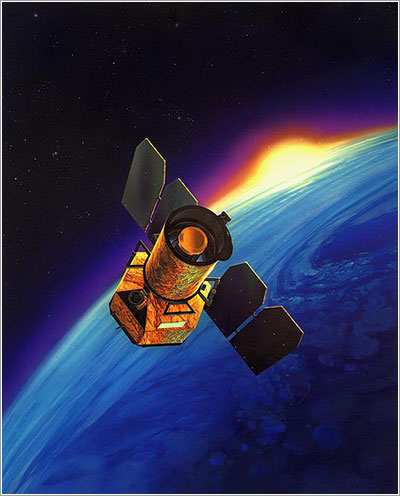
Impresión artística del GALEX en órbita
Lanzado el 28 de abril de 2003 por un cohete Pegasus XL, igual que el IRIS hace apenas unos días, el GALEX era un telescopio para observar galaxias en el ultravioleta.
La duración inicial prevista de su misión era de 29 meses, pero al final ha estado en servicio durante un poquito más de diez años, aunque desde 2012 era el Instituto Tecnológico de California quien lo gestionaba.
Pero finalmente la NASA ha decidido poner fin a la misión, tal y como se puede leer en NASA Decommissions Its Galaxy Hunter Spacecraft .
Durante este tiempo GALEX, el Explorador de la Evolución Galáctica, ha descubierto cosas como anillos de estrellas nuevas alrededor de viejas galaxias muertas, ha ayudado a confirmar lo que es la energía oscura, y ha permitido localizar galaxias durante su paso desde su juventud a su madurez que no se habían visto nunca antes.
En total ha observado varios cientos de millones de galaxias a través de unos 10.000 millones de años; una peculiaridad de su modo de funcionamiento era que sólo realizaba sus observaciones cuando estaba a la sombra de la Tierra, donde era de noche.
En GALEX - Image Gallery hay unas cuantas imágenes de las que ha generado, aunque los científicos aún tardarán años en acabar de analizar todos los datos conseguidos por este telescopio.
La nave en si se calcula que aun seguirá en órbita otros 65 años antes de caer a la atmósfera.
via Microsiervos http://www.microsiervos.com/archivo/ciencia/la-nasa-retira-el-galex-su-observatorio-espacial-de-galaxias.html
The After Math: Microsoft fits new Windows, Sony pushes the limits of a smartphone screen

These Pics Could Be the Colorful New Entry-Level iPhone

BSkyB wins trademark case against Microsoft over SkyDrive name

Rockall, el peñasco donde acaba Europa por el oeste (o no)
Como gallego siempre he oído decir que el punto más al oeste de toda Europa –o al menos de la Europa continental, ya que los récords son siempre matizables– es el Cabo Finiesterre, y hasta hace unas horas no sabía que en realidad está más al oeste el cabo de la Roca, aunque los romanos por lo visto no lo sabían y se limitaron a llamarlo Promontorium Magnum, de ahí el lío.
Aún teniendo en cuenta islas más o menos lejanas como parte del continente habría dicho que el punto más al oeste de Europa le correspondería a algún lugar de Irlanda, pero según se puede leer en Puntos extremos de Europa en realidad el punto más al oeste de Europa es el islote de Monchique, cerca de Fajã Grande, en la isla de Flores, en las Azores.
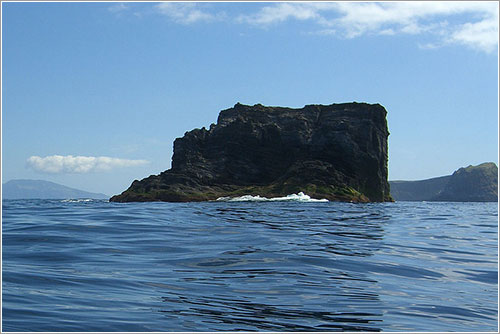
El islote de Monchique por Dreizung
Pero incluso no incluyendo estas islas remotas resulta que el punto más al oeste de Europa es Bjargtangar, Islandia, donde hay un faro que luce una placa que dice The West, el Oeste.
El punto más al oeste de Irlanda es la isla Tearaght, que está a unos 12,5 kilómetros al oeste de la península Dingle, que es donde está Punta Garraun, que es la parte más al oeste de Irlanda sin contar las islas que rodean a la isla principal.
Toda esta excursión por los distintos extremos oeste de Europa viene de leer Rockall, la piedra donde termina Europa, una anotación sobre un pedrusco inhóspito de 31 metros de largo por 25 de ancho y 21 de altura más o menos a medio camino entre Irlanda e Islandia cuya soberanía se disputan ahora ambas junto con Dinamarca y el Reino Unido.
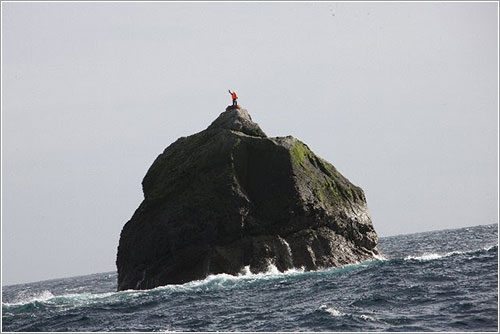
Un aficionado subido a Rockall; hay gente «pa tó»
Aunque ya se conocía su existencia al menos desde el siglo XVI, cuando aparecen las primeras referencias escritas a él, nadie puso un pie en Rockall hasta principios del XIX y no fue hasta el 21 de septiembre de 1955 cuando alguien decidió reclamar la soberanía sobre él.
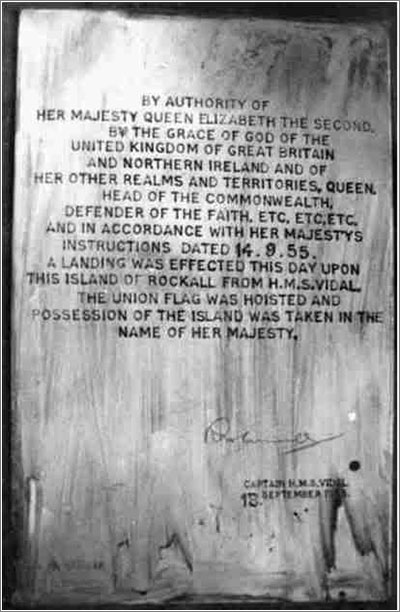
La placa que reclama la soberanía de Rockall para el Reino Unido, que alguien se llevó en algún momento entre 1997 y 2010
Esto fue porque el Reino Unido pensó entonces que a la Unión Sovietica se le podía ocurrir montar allí un puesto de seguimiento para obtener datos sobre las pruebas de lanzamiento de misiles nucleares desde submarinos que los británicos estaban realizando por esa zona.
Con el tiempo y el final de la guerra fría esta posibilidad pasó a ser realmente remota, más aún que Rockall, pero desde entonces son los intereses económicos por lo que pueda haber bajo la plataforma continental sobre la que se asienta el islote lo que hace que sea una cuestión a debate a quien le pertenece este.
via Microsiervos http://www.microsiervos.com/archivo/curiosidades/rockall-el-penasco-donde-acaba-europa-por-el-oeste-o-no.html
Inhabitat's Week in Green: cardboard bicycle, robo raven and a steampunk Lego ship

Rockall, el pañasco donde acaba Europa por el oeste (o no)
Como gallego siempre he oído decir que el punto más al oeste de toda Europa –o al menos de la Europa continental, ya que los récords son siempre matizables– es el Cabo Finiesterre, y hasta hace unas horas no sabía que en realidad está más al oeste el cabo de la Roca, aunque los romanos por lo visto no lo sabían y se limitaron a llamarlo Promontorium Magnum, de ahí el lío.
Aún teniendo en cuenta islas más o menos lejanas como parte del continente habría dicho que el punto más al oeste de Europa le correspondería a algún lugar de Irlanda, pero según se puede leer en Puntos extremos de Europa en realidad el punto más al oeste de Europa es el islote de Monchique, cerca de Fajã Grande, en la isla de Flores, en las Azores.

El islote de Monchique por Dreizung
Pero incluso no incluyendo estas islas remotas resulta que el punto más al oeste de Europa es Bjargtangar, Islandia, donde hay un faro que luce una placa que dice The West, el Oeste.
El punto más al oeste de Irlanda es la isla Tearaght, que está a unos 12,5 kilómetros al oeste de la península Dingle, que es donde está Punta Garraun, que es la parte más al oeste de Irlanda sin contar las islas que rodean a la isla principal.
Toda esta excursión por los distintos extremos oeste de Europa viene de leer Rockall, la piedra donde termina Europa, una anotación sobre un pedrusco inhóspito de 31 metros de largo por 25 de ancho y 21 de altura más o menos a medio camino entre Irlanda e Islandia cuya soberanía se disputan ahora ambas junto con Dinamarca y el Reino Unido.

Un aficionado subido a Rockall; hay gente «pa tó»
Aunque ya se conocía su existencia al menos desde el siglo XVI, cuando aparecen las primeras referencias escritas a él, nadie puso un pie en Rockall hasta principios del XIX y no fue hasta el 21 de septiembre de 1955 cuando alguien decidió reclamar la soberanía sobre él.

La placa que reclama la soberanía de Rockall para el Reino Unido, que alguien se llevó en algún momento entre 1997 y 2010
Esto fue porque el Reino Unido pensó entonces que a la Unión Sovietica se le podía ocurrir montar allí un puesto de seguimiento para obtener datos sobre las pruebas de lanzamiento de misiles nucleares desde submarinos que los británicos estaban realizando por esa zona.
Con el tiempo y el final de la guerra fría esta posibilidad pasó a ser realmente remota, más aún que Rockall, pero desde entonces son los intereses económicos por lo que pueda haber bajo la plataforma continental sobre la que se asienta el islote lo que hace que sea una cuestión a debate a quien le pertenece este.
via Microsiervos http://www.microsiervos.com/archivo/curiosidades/rockall-el-panasco-donde-acaba-europa-por-el-oeste-o-no.html
Benchmark's Eisenberg And Face.com's Shochat Raise $120M+ For Aleph, An Early-Stage Fund For Israeli Startups

Two veteran investors who have been integral in the development of a new generation of Israeli startups are on a mission to reverse a trend in a country that has traditionally favored later-stage and enterprise-skewed venture capital. Benchmark’s Michael Eisenberg and Genesis Partners’ Eden Shochat are teaming up to create Aleph — a new fund that aims to bring some much-needed local, early-stage support to Israeli startups. TechCrunch hears that the VC’s first fund is nearly closed and is in the region of $120 million.
Given that the venture capital (and startup) landscape in Israel is at a potentially significant juncture — the most recent exit being Waze to Google for $1.1 million — the founders want to strike while the iron is hot. And they’re setting the bar high: They want Aleph to become the go-to early-stage venture capital firm in Israel, our sources tell us.
Israel has a long, prolific history when it comes to supporting innovation in science and technology. Today, the percentage of its population working in science and tech — and the amount it spends on R&D (relative to its GDP) — is reportedly the highest of any country in the world. One can begin to see why Israel has become home to the R&D centers of over 250 multinationals, including Google, Oracle, Microsoft and IBM.
It also helps explain why Israeli tech has, traditionally, been known for its focus on hardcore technologies (like software and semiconductors, for example) and enterprise. Yet, in spite of the fact that local venture capital has favored deep-tech and later-stage investments, over the last few years, a new generation of consumer startups has begun to emerge. (And produce some big companies and exits — like addictive traffic app, Waze, which just sold to Google for $1.1 billion and website creation platform, Wix, which recently announced its intentions to go public.)
So far, Aleph has been very tight-lipped on the actual existence of the fund, and what its aims are going to be. Initial reports, which first surfaced in Israeli newspaper The Globes earlier this week, pegged the new fund at $100 million. Though the founders have declined to share details at this point, and Israeli publications have floated several different figures, the consensus from our sources indicates that the total will be around $120 million and that it is expected to close in the next few weeks.
But why should you care about some Israeli venture capital fund — or the size of the fund, for that matter? Great question, reader. I like you.
For starters, this is a sign of how startup tides are beginning to change in Israel. The success of companies like Waze and Wix could be a signal to the country’s entrepreneurs that there’s opportunity in not just “consumerizing,” but in making “tech-focused” consumer plays — like, say, in applying intelligent, “Big Data” technologies to consumer-facing services. For example, Waze, while it is known for it’s fun, animated, cartoony interface, considers itself a Big Data company and is obsessed with building infrastructure that can allow it to crunch enormous amounts of realtime traffic and navigational data points, which it can then use to personalize its maps and optimize the turn-by-turn navigational experience.
Plus, the fact that Aleph is raising a $120 million-plus early-stage fund shows that it’s serious and gives it enough capital to begin making a difference in a relatively small tech ecosystem. It’s not clear yet how much Aleph will invest in its chosen startups, but if we can assume it will be investing somewhere between $5 million and $8 million in each deal, that means it will be making anywhere between 15 to 25 investments. There’s room in that part of the market in Israel, and at those amounts, Aleph can provide enough early-stage capital to potentially change the fate of Israeli startups that have been struggling to find access.
In comparison, Pitango Venture Capital, which Haaretz calls Israel’s biggest VC firm, has reportedly raised $150 million of a $250 million fund, which will be its sixth. Furthermore, Magma Venture Partners, which was one of two Israeli firms to invest in Waze, recently raised $100 million. Qumra Capital is also in the process of raising $100 million for its first fund, according to Haaretz.
But all in all, we hear that local funds are, by and large, having difficulty raising in the current climate, while, in comparison, Aleph has will already be in the same league with some of the country’s biggest funds. And, while the founders declined to share details or confirm any of the above (or below), we’ve also heard that the founders initially set out to raise $100 million, but extended the target to $120 to $150 million after finding plenty of interest. With its model, in combination with the current landscape and maturing startup economy, the founders think the timing is right for a new, dominant venture firm to emerge in the Israeli market.
It’s way too early to say either way, but the other important factor at play here for Israeli startups is how much experience both Eisenberg and Shochat bring to the table as investors (and entrepreneurs). Eisenberg has been a general partner at Benchmark Capital in Israel for over eight years and has served on the Board of Directors for companies like Answer.com and Shopping.com and currently sits on the board of directors at Gigya, Seeking Alpha, Clarizen, Conduit (whose last raise valued the company at $1.4 billion) and Wix. Shochat, on the other hand, has been a General Partner at Genesis for almost three years, but also has significant experience as an operator.
In that capacity, he is probably best known as the co-founder and chairman of Face.com, a facial recognition technology company that sold to Facebook for upwards of $60 million. He is also the co-founder of Aternity, has led investments in successful startups like Any.do, JoyTunes and Commerce Sciences and helped manage and lead “TheJunction,” a program created by Genesis to support early-stage entrepreneurs by offering co-working space and acting as a startup accelerator and alumni organization, a la 500 Startups.
Shochat reportedly left Genesis in April, and Eisenberg will be leaving his role at Benchmark. With their prior experience, sources tell us that Aleph’s goal is to dominate early-stage IT, cloud, Big Data and mobile investments in Israel, leveraging what they perceive to be a maturation of next-gen local entrepreneurs looking to build big, global (and even consumer-facing) companies. For them, standing out from the crowd will be about focusing on Series A investments, rapid decision-making, local support and being decidedly entrepreneur-friendly,
Not only that, but our sources indicate that, in spite of the fact that Eisenberg is leaving Benchmark to start Aleph, Benchmark is one of the new firm’s first investors. Not to overstate it, but if these reports are in fact true, it’s a notable vote of confidence from Benchmark and shows what they think of his track record.
Regardless, the emergence of Aleph is an auspicious sign for the Israeli startup ecosystem, giving entrepreneurs another critical lifeline during the early stages, and another indication of how much Israeli tech stands to benefit from the global attention following a string of high-profile exits, chief of which is, of course, the newly minted “GoogleWaze”. (Or Wazoogle, if you prefer.)
We’ve reached out to the founders and will update with their comments if and when they respond.
via TechCrunch » Startups http://feedproxy.google.com/~r/techcrunch/startups/~3/CK37bPq1Ynw/
Yahoo decide cerrar AltaVista

AltaVista en los viejos buenos tiempos de 1996
Hace años que dejó de ser relevante, pero a partir del 8 de julio Yahoo da el carpetazo definitivo a AltaVista, el primer buscador que muchos llegamos a utilizar con asiduidad a mediados-finales de los 90 hasta que llegó Google y arrasó con él y con prácticamente todos los demás.
En realidad desde que lo adquirió allá por 2003 Yahoo ha ido migrando componentes de AltaVista a su propio buscador, así que la tecnología per se no desaparece, aunque a partir del 8 de julio de 2013 altavista.com dejará de existir.
AltaVista es una de las víctimas de la última limpieza emprendida por Marissa Mayer; el resto de los agraciados se pueden comprobar en Keeping our Focus on What’s Next .
A ver si os creíais que sólo Google hace limpiezas de primavera.
(Vía La Voz de Galicia).
via Microsiervos http://www.microsiervos.com/archivo/internet/yahoo-decide-cerrar-altavista.html
La tabla periódica de donde se descubrió cada elemento
En The Periodic Table of National pride , un trabajo de @JamieBGall, se pueden ver los elementos químicos y el pais en el que fueron descubiertos.
A ojo hubiera apostado por los Estados Unidos como país que más elementos ha descubierto, pero en realidad es el Reino Unido con 23 frente a los 17 de EE UU; de hecho tanto Suecia como Alemania le ganan también con 19 elementos cada uno.
España se tiene que conformar con dos, el wolframio (quizás más conocido como tungsteno) y el platino, ambos en el siglo XVIII.
Desde entonces, nada de nada.
(Vía @litho_war).
via Microsiervos http://www.microsiervos.com/archivo/ciencia/la-tabla-periodica-de-donde-se-descubrio-cada-elemento.html
